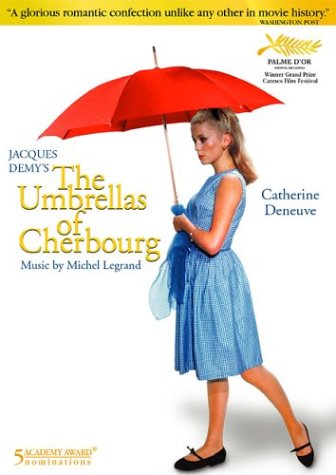All Nonfiction
- Bullying
- Books
- Academic
- Author Interviews
- Celebrity interviews
- College Articles
- College Essays
- Educator of the Year
- Heroes
- Interviews
- Memoir
- Personal Experience
- Sports
- Travel & Culture
All Opinions
- Bullying
- Current Events / Politics
- Discrimination
- Drugs / Alcohol / Smoking
- Entertainment / Celebrities
- Environment
- Love / Relationships
- Movies / Music / TV
- Pop Culture / Trends
- School / College
- Social Issues / Civics
- Spirituality / Religion
- Sports / Hobbies
All Hot Topics
- Bullying
- Community Service
- Environment
- Health
- Letters to the Editor
- Pride & Prejudice
- What Matters
- Back
Summer Guide
- Program Links
- Program Reviews
- Back
College Guide
- College Links
- College Reviews
- College Essays
- College Articles
- Back
The Umbrellas of Cherbourg (Les Parapluies de Cherbourg)
The first notes heard in The Umbrellas of Cherbourg are those of a solo flute playing the notes of the central melody: “I Will Wait for You.” A French horn then echoes this melody, adding harmony. More instruments come into play in a quasi-canon of the melody. The orchestra plays in unison as the main titles appear in front of a line of brightly colored umbrellas. The music is haunting, romantic, and has a hypnotic sound to it. We hear it and immediately we are in love.
And so begins the film: a beautifully acted and executed film where all of the dialogue is sung and the actors move with such fluidity, they seem to dance rather than move. A film where the most ordinary of images seem about as beautiful as rose petals.
This is the work of Jacques Demy, whose intention of making this movie was to bring to the silver screen something different and unique. Sure enough, he succeeded.
The film’s plot is rather simple: Gas station attendant Guy (Nino Castelnuovo) and umbrella shop clerk Genevieve (Catherine Denuve) are truly, madly, deeply in love. They fantasize about married life, do not seem to care for arguments with one another, and they both feel as though they are complete when the other is with them. When Guy is drafted, Genevieve must come to terms with the fact that she may never see Guy again. Her mother wants her to forget about Guy and marry a man solely for the purpose of financial security. Genevieve finds that hard to do, seeing as she is carrying Guy’s child.
Umbrellas’ plot may seem to be one you would find in a bargain-rack novelette, though Demy creates a unique and magical cinematic experience through his use of color, music, and images. An umbrella shop filled with purple wallpaper, a gas station covered with snow, all of these images are exhilarating to watch on the big or small screen.
Though, when it was first released, Demy was nervous about the quality of the colors on the film’s negatives. Demy shot Umbrellas on Eastman negative stock which ultimately faded rapidly and was nearly unusable. After being circulated so much around theaters in the ‘60s, the colors on the negatives began to fade meaning audience could not be seen with the rich colors Demy intended.
In response, he made black and white copies of the original in a process similar to that of the Technicolor process called “three color bands.” Fortunately for Demy, these prints had a greater longevity and in the 1990’s, Demy’s wife helped fund a project to create a color print from the black and white copies.
The result?
The film as we know it today.
The film has a long history also with its composer and leading lady. Michael Legrand, because of this film, enjoyed an enormous amount of acclaim and success in Hollywood and quickly established himself as a composer of great passion, emotion, and originality. The score was nominated for two Academy Awards, Best Original Score & Best Scoring—Adaptation or Treatment.”
Umbrellas’ most famous song, “I Will Wait for You”, was nominated for Best Original Song and has been recorded by everyone from Frank Sinatra to the London Philharmonic. Tony Bennett recorded the song “Watch What Happens”, using the theme from “Cassard’s Story” in the film with new English lyrics.
The film also launched the career of its leading lady, Catherine Deneuve. Audiences saw her raw, emotional power in Genevieve and immediately knew that many great things would come of her. Over one year after Umbrellas was released, an up-and-coming director by the name of Roman Polanski would direct Deneuve in a disturbing and claustrophobic movie called Repulsion, which would establish Deneuve as an actress who could play and own any role given to her.
Umbrellas has a way of dazzling the senses of its audience. The colors on the screen combined with Michael Legrand’s continuous musical score make for a truly magical cinematic experience. Critics and viewers throughout the ages have all but criticized this film; it is a rare gem of a movie that, from the get-go, captures our interest and emotions and keeps them close to us, never letting go.
Even if you are not a fan of subtitled movies, operas, or musicals, Umbrellas will surely change your mind, even if it’s just for a second. We live in the movie, we feel all of the characters’ emotions in each frame which makes the ending of the film even more riveting that the last screening (JC).
Similar Articles
JOIN THE DISCUSSION
This article has 0 comments.

